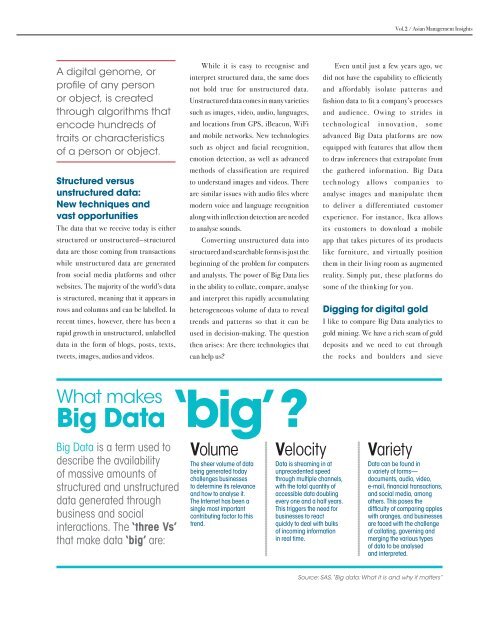SMU_AMI_November_Spread
You also want an ePaper? Increase the reach of your titles
YUMPU automatically turns print PDFs into web optimized ePapers that Google loves.
Vol.2 / Asian Management Insights<br />
A digital genome, or<br />
profile of any person<br />
or object, is created<br />
through algorithms that<br />
encode hundreds of<br />
traits or characteristics<br />
of a person or object.<br />
Structured versus<br />
unstructured data:<br />
New techniques and<br />
vast opportunities<br />
The data that we receive today is either<br />
structured or unstructured—structured<br />
data are those coming from transactions<br />
while unstructured data are generated<br />
from social media platforms and other<br />
websites. The majority of the world’s data<br />
is structured, meaning that it appears in<br />
rows and columns and can be labelled. In<br />
recent times, however, there has been a<br />
rapid growth in unstructured, unlabelled<br />
data in the form of blogs, posts, texts,<br />
tweets, images, audios and videos.<br />
While it is easy to recognise and<br />
interpret structured data, the same does<br />
not hold true for unstructured data.<br />
Unstructured data comes in many varieties<br />
such as images, video, audio, languages,<br />
and locations from GPS, iBeacon, WiFi<br />
and mobile networks. New technologies<br />
such as object and facial recognition,<br />
emotion detection, as well as advanced<br />
methods of classification are required<br />
to understand images and videos. There<br />
are similar issues with audio files where<br />
modern voice and language recognition<br />
along with inflection detection are needed<br />
to analyse sounds.<br />
Converting unstructured data into<br />
structured and searchable forms is just the<br />
beginning of the problem for computers<br />
and analysts. The power of Big Data lies<br />
in the ability to collate, compare, analyse<br />
and interpret this rapidly accumulating<br />
heterogeneous volume of data to reveal<br />
trends and patterns so that it can be<br />
used in decision-making. The question<br />
then arises: Are there technologies that<br />
can help us?<br />
Even until just a few years ago, we<br />
did not have the capability to efficiently<br />
and affordably isolate patterns and<br />
fashion data to fit a company’s processes<br />
and audience. Owing to strides in<br />
technological innovation, some<br />
advanced Big Data platforms are now<br />
equipped with features that allow them<br />
to draw inferences that extrapolate from<br />
the gathered information. Big Data<br />
technology allows companies to<br />
analyse images and manipulate them<br />
to deliver a differentiated customer<br />
experience. For instance, Ikea allows<br />
its customers to download a mobile<br />
app that takes pictures of its products<br />
like furniture, and virtually position<br />
them in their living room as augmented<br />
reality. Simply put, these platforms do<br />
some of the thinking for you.<br />
Digging for digital gold<br />
I like to compare Big Data analytics to<br />
gold mining. We have a rich seam of gold<br />
deposits and we need to cut through<br />
the rocks and boulders and sieve<br />
What makes<br />
Big Data<br />
Big Data is a term used to<br />
describe the availability<br />
of massive amounts of<br />
structured and unstructured<br />
data generated through<br />
business and social<br />
interactions. The ‘three Vs’<br />
that make data ‘big’ are:<br />
‘big’?<br />
Volume<br />
The sheer volume of data<br />
being generated today<br />
challenges businesses<br />
to determine its relevance<br />
and how to analyse it.<br />
The Internet has been a<br />
single most important<br />
contributing factor to this<br />
trend.<br />
Velocity<br />
Data is streaming in at<br />
unprecedented speed<br />
through multiple channels,<br />
with the total quantity of<br />
accessible data doubling<br />
every one and a half years.<br />
This triggers the need for<br />
businesses to react<br />
quickly to deal with bulks<br />
of incoming information<br />
in real time.<br />
Variety<br />
Data can be found in<br />
a variety of forms—<br />
documents, audio, video,<br />
e-mail, financial transactions,<br />
and social media, among<br />
others. This poses the<br />
difficulty of comparing apples<br />
with oranges, and businesses<br />
are faced with the challenge<br />
of collating, governing and<br />
merging the various types<br />
of data to be analysed<br />
and interpreted.<br />
Source: SAS, “Big data: What it is and why it matters”


